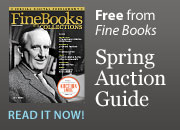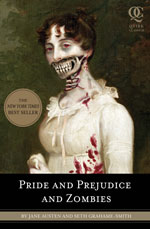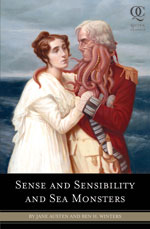Quirk(y) Classics
If only Jane Austen could see her women now! By Rebecca Rego Barry
When Pride and Prejudice was first published in 1813, Jane Austen wrote to her sister Cassandra, “The work is rather too light, and bright, and sparkling; it wants shade; it wants to be stretched out here and there with a long chapter of sense, if it could be had; if not, of solemn specious nonsense, about something unconnected with the story … anything that would form a contrast, and bring the reader with increased delight to the playfulness and epigrammatism of the general style.”
It’s certain that Austen could not have imagined zombies as a source of “shade,” or “nonsense” or “contrast” when she penned that letter (according to the Oxford English Dictionary, zombie first appeared in the lexicon six years later). Yet the recently published Pride and Prejudice and Zombies was an overnight success; it has been on The New York Times bestseller list for more than 18 weeks, the publisher has 750,000 paperbacks in print, and a “deluxe heirloom edition” with oil-painting illustrations and a faux-leather binding will be on shelves for the holidays.
Comprised of 85 percent original text and 15 percent “bone-crunching zombie mayhem,” written by Seth Grahame-Smith, P&P&Z conjures an England that has been invaded by the living dead, where even the Bennet sisters must arm and defend themselves.
Marsha Huff, president of the Jane Austen Society of North America (JASNA), said that once you accept the premise, the blend is well-done.
“It is a satiric version of a satiric novel,” she said.
Adding brain-eating zombies to Austen’s classic novel was the brainchild of Quirk Books editorial director Jason Rekulak. The idea began to germinate about two years ago, when he became “really intrigued by all the creative copyright infringement on the web,” in which different media products are mashed-up to make something new. He predicted this could work in book publishing, presuming he used public domain titles. So he made a list of titles and another list of strange things—such as zombies or monkeys—that could be inserted to “enhance those works,” he said.
The idea was met with some skepticism at the Philadelphia-based publishing house where Rekulak works. But even before the book was introduced last winter at the San Diego Comic-Con—the largest comic book and popular arts convention in the world—a fan base was forming.
Rekulak says the overlap between Austen aficionados and horror/fantasy devotees has been greater than he imagined. He estimated that 80 percent of Austen readers have enjoyed the new violent version of the text.
“What I find is that most Austen fans are so fed up with all the Regency Pride and Prejudice sequels … they appreciate the originality of this idea,” Rekulak said.
Huff said that reaction has been mixed among JASNA members. Some have found the bloody scenes too gruesome, she said. Others have noted the more pronounced feminist subtext. “In P&P&Z, the women are empowered. The clever ones receive training in the martial arts,” said Huff. “It is a liberating aspect of the novel that I think some of our members have appreciated.”
In general, however, JASNA members have been excited about all the attention Austen has received. Huff said she believes that P&P&Z has enticed people, especially young people, to read Austen, and “that’s a good thing.”
On September 15, Quirk Classics will publish its second mash-up, Sense and Sensibility and Sea Monsters, which begs the question: are they planning to “enhance” Austen’s entire canon?
“We want to mix it up and stretch the formula,” said Rekulak. “We’re going to do more, but not just a formula of Austen plus monsters.”










